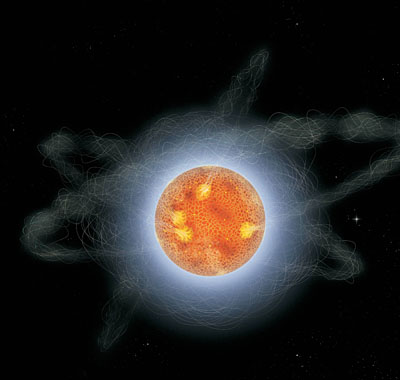Neutron stars are the most magnetized objects in our Universe. Some of them, dubbed "Magnetars" have a record magnetic field of 1011 Tesla (T), which corresponds to one million of billions times that of the Sun during a quiescent phase. It's around this class of objects that an over-density of electrons has been discovered. These results, delivered by an international team of researchers that includes Diego Götz from the Service d'Astrophysique of CEA-Irfu, is the result of a careful analysis of the X-ray emission observed with the satellites of the European Space Agency (ESA) XMM-Newton and INTEGRAL. The enormous battery represented by the highly magnetized neutron stars provides its magnetosphere with electrons in a much efficient way, with respect to other neutron stars. These physical phenomena, completely inaccessible in laboratory experiments due to the enormous magnetic fields required, allow to better understand the behavior of matter in extreme conditions. This work has been published by The Astrophysical Journal, and has been the object of a press release by ESA.

Rotating magnetized neutron stars, aka pulsars, are embedded in an electron cloud which composes their magnetosphere. In the Magnetar case, the magnetic field reaches an extreme value, impossible to be obtained in our laboratories, making of these objects the most powerful magnets in our Universe. The photons emitted by the hot surface of the neutron stars propagate through the magnetosphere. Under the effect of the magnetic field and of the electron plasma, they are up-scattered to high energies, making the Magnetars powerful X-ray emitters. By studying the properties of this radiation our a large sample of Magnetars, scientists managed to measure the electron density needed to explain these observations. They conclude that the density must be 1000 times higher than in regular pulsars.
Artist impresstion of a magnetar (Credit: Sky and Telescope 2008, Gregg Dindermann)
Contact :
"Resonant cyclotron scattering in magnetars' emission"
N. Rea, S. Zane, R. Turolla,2, M. Lyutikov and D. Götz
published in The Astrophysical Journal 2008, October
For an electronic version (format PDF, 2.2 Mb)
See also : the ESA press release with its complementary informations
Pour en savoir plus : - the website XMM-Newton of the Service d'Astrophysique
: - le site INTEGRAL du Service d'Astrophysique (in french)
Note :
[1]Magnetars are, just like pulsars, isolated rotating neutron stars. A neutron star is the product of a supernova, the explosion of a massive star at the end of its life. Magnetars, whose existence was theoretically predicted in 1992, have magnetic fields up to 1015 Gauss, i.e. 1011 Tesla (T). This value is 1000 times higher than the magnetic field of common pulsars. The X-ray emission of Magnetars exceeds the rotational energy loss for the neutron star. The latter mechanism, which is used to explain the radio pulsar emission, can hence not be applied to these sources. The main energy source in Magnetars is then the huge magnetic field itself. These objects are much rarer than pulsars: about fifteen sources are actually considered Magnetars or Magnetar candidates, while our Galaxy contains at least 2000 radio pulsars.
Rédaction : Christian Gouiffès
• Structure and evolution of the Universe › High energy cosmic phenomena and astroparticles Structure and evolution of celestial bodies
• Department of Astrophysics (DAp) // UMR AIM




